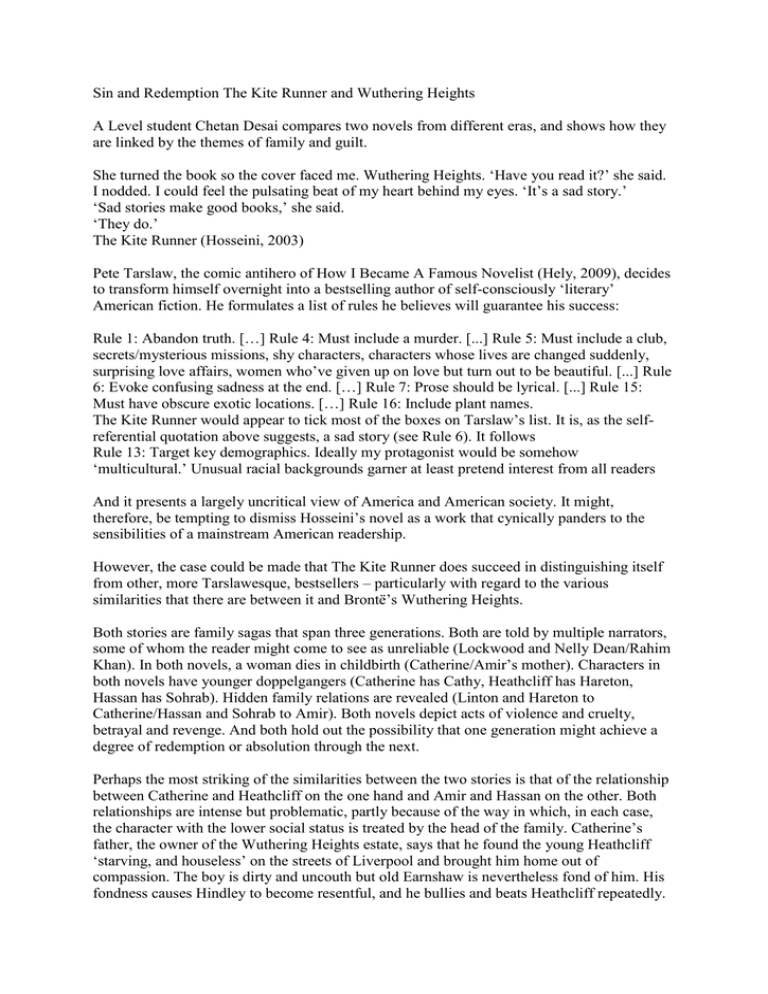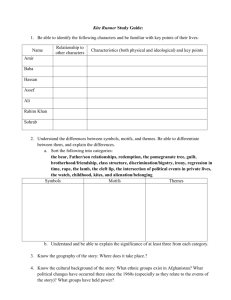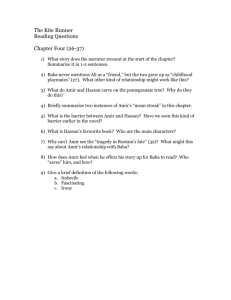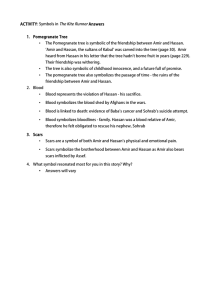File - English Literature A LEVEL
advertisement

Sin and Redemption The Kite Runner and Wuthering Heights A Level student Chetan Desai compares two novels from different eras, and shows how they are linked by the themes of family and guilt. She turned the book so the cover faced me. Wuthering Heights. ‘Have you read it?’ she said. I nodded. I could feel the pulsating beat of my heart behind my eyes. ‘It’s a sad story.’ ‘Sad stories make good books,’ she said. ‘They do.’ The Kite Runner (Hosseini, 2003) Pete Tarslaw, the comic antihero of How I Became A Famous Novelist (Hely, 2009), decides to transform himself overnight into a bestselling author of self-consciously ‘literary’ American fiction. He formulates a list of rules he believes will guarantee his success: Rule 1: Abandon truth. […] Rule 4: Must include a murder. [...] Rule 5: Must include a club, secrets/mysterious missions, shy characters, characters whose lives are changed suddenly, surprising love affairs, women who’ve given up on love but turn out to be beautiful. [...] Rule 6: Evoke confusing sadness at the end. […] Rule 7: Prose should be lyrical. [...] Rule 15: Must have obscure exotic locations. […] Rule 16: Include plant names. The Kite Runner would appear to tick most of the boxes on Tarslaw’s list. It is, as the selfreferential quotation above suggests, a sad story (see Rule 6). It follows Rule 13: Target key demographics. Ideally my protagonist would be somehow ‘multicultural.’ Unusual racial backgrounds garner at least pretend interest from all readers And it presents a largely uncritical view of America and American society. It might, therefore, be tempting to dismiss Hosseini’s novel as a work that cynically panders to the sensibilities of a mainstream American readership. However, the case could be made that The Kite Runner does succeed in distinguishing itself from other, more Tarslawesque, bestsellers – particularly with regard to the various similarities that there are between it and Brontë’s Wuthering Heights. Both stories are family sagas that span three generations. Both are told by multiple narrators, some of whom the reader might come to see as unreliable (Lockwood and Nelly Dean/Rahim Khan). In both novels, a woman dies in childbirth (Catherine/Amir’s mother). Characters in both novels have younger doppelgangers (Catherine has Cathy, Heathcliff has Hareton, Hassan has Sohrab). Hidden family relations are revealed (Linton and Hareton to Catherine/Hassan and Sohrab to Amir). Both novels depict acts of violence and cruelty, betrayal and revenge. And both hold out the possibility that one generation might achieve a degree of redemption or absolution through the next. Perhaps the most striking of the similarities between the two stories is that of the relationship between Catherine and Heathcliff on the one hand and Amir and Hassan on the other. Both relationships are intense but problematic, partly because of the way in which, in each case, the character with the lower social status is treated by the head of the family. Catherine’s father, the owner of the Wuthering Heights estate, says that he found the young Heathcliff ‘starving, and houseless’ on the streets of Liverpool and brought him home out of compassion. The boy is dirty and uncouth but old Earnshaw is nevertheless fond of him. His fondness causes Hindley to become resentful, and he bullies and beats Heathcliff repeatedly. Catherine, however, forms a strong bond with Heathcliff, and the two become inseparable, and rather wild, playmates. The affection shown by old Earnshaw towards Heathcliff is similar to that shown to Hassan by Baba, and a similar sort of tension is created. Baba, a high-status Sunni Pashtun, is the prosperous owner of ‘the most beautiful house in […] a new and affluent neighborhood in […] Kabul’, while Hassan is a member of the oppressed Shiite Hazara minority. Amir as it were plays the role both of Catherine and of Hindley, for although he and Hassan are constant boyhood companions, he is jealous of Baba’s regard for Hassan, who, as far as he knows, is the son of the household servant, Ali. We later learn that Hassan is in fact Amir’s halfbrother, the issue of Baba’s secret affair with Ali’s runaway wife. The revelation about Hassan’s true parentage might prompt us to consider the intriguing, if tangential, possibility that old Earnshaw might not have been entirely honest about the circumstances that brought Heathcliff to Wuthering Heights. Is Heathcliff the illegitimate son of Mr Earnshaw just as Hassan is Baba’s? If so, who is Heathcliff’s mother? Speculations such as these are perhaps the inevitable side-effect of an exercise in comparative scrutiny. The process of teasing out the intertextuality between The Kite Runner and Wuthering Heights – which is manifested in the shared themes already discussed above – can stimulate new ideas that might not otherwise come to light. Each text can be seen through the lens of the other, and alternative narrative possibilities might thus emerge that supplement and branch off from the well-laid fictive tracks of the original works. Betrayal and Guilt The incestuousness of the relationship between Catherine and Heathcliff, though underplayed in the original text, is a theme which is nevertheless present: the two grow up in the same house, with the same father figure, and a powerful attachment forms between them. But the depiction of a tempestuous love affair (of sorts) between half-siblings would probably have been unpalatable to Brontë’s readers, and the possibility would therefore have had to be excluded from the narrative, if indeed it occurred to the author at all. In any case, Catherine and Heathcliff’s relationship in Wuthering Heights is already complicated enough. On Catherine’s part, there is an almost complete identification with Heathcliff. She declares, ‘I am Heathcliff’. Nevertheless, she shortly afterwards chooses to marry Edgar Linton. Her decision devastates Heathcliff, who sees it as a betrayal of his intense feelings for her: If he [Edgar] loved with all the powers of his puny being, he couldn’t love as much in eighty years as I could in a day and he disappears for three years. Catherine rationalises her intention to marry Edgar, perhaps somewhat disingenuously, by saying she will be able to ‘aid Heathcliff to rise, and place him out of my brother’s power’. An even feebler attempt at self-justification is made by Amir, who, wracked with guilt over his failure to intervene in Assef’s rape of Hassan, and no longer able to tolerate Hassan’s presence, carefully prepares to frame his friend for the theft of a watch, an apparent crime which he hopes will result in Baba’s dismissing Hassan from his service: the same image kept flashing in my mind over and over: Hassan, his head downcast, serving drinks to Assef […] Maybe it would be for the best. Lessen his suffering. Early in the novel, Amir describes Hassan as a boy with an ‘almost perfectly round face, a face like a Chinese doll’ and goes on to tell us that ‘Hassan never denied me anything’. Amir carves the words ‘Amir and Hassan, the sultans of Kabul’ on the trunk of a pomegranate tree that he and Hassan would climb together. Amir pretends to read a story to the illiterate Hassan whilst actually improvising it, and Hassan praises the story as the best that Amir has told for a long time. I laughed. Clutched him in a hug and planted a kiss on his cheek. ‘What was that for?’ he said, startled, blushing. I gave him a friendly shove. Smiled. ‘You’re a prince, Hassan. You’re a prince and I love you.’ Hassan’s loyalty to Amir is unfaltering. He intervenes and protects Amir with his slingshot when the sadistic bully Assef is about to beat him up. Later, Hassan chases down the winning kite in the kite-flying contest – ‘For you a thousand times over’ – and refuses to surrender it when Assef threatens him, choosing instead to endure the violent humiliation that follows. For the reader, the closeness of Amir and Hassan’s friendship before the rape, and Hassan’s continued loyalty after it, are perhaps what make the impact of Amir’s subsequent betrayal all the greater. Haunted by the Past The guilt that Amir feels is the driving force of the narrative. It has haunted him all his life. It’s wrong what they say about the past […] about how you can bury it. Because the past claws its way out. Looking back now, I realize I have been peeking into that deserted alley for the last twenty-six years The guilt, and the tantalising possibility that Rahim Khan holds out that ‘There is a way to be good again’ – the possibility of redemption – are what motivate Amir to return to Afghanistan to confront his ‘past of unatoned sins’. Similar in tone and mood is the way in which Heathcliff reacts to Catherine’s death. Everywhere there are reminders of her: In every cloud, in every tree – filling the air at night, and caught by glimpses in every object by day – I am surrounded with her image! The most ordinary faces of men and women – my own features – mock me with a resemblance. The entire world is a dreadful collection of memoranda that she did exist, and that I have lost her! He becomes morbidly obsessed with the fantastical idea of being reunited with her, even going so far as to dig up her grave. His increasingly disturbing behaviour is arguably motivated not just by intense grief but also by guilt: Heathcliff knows that his confrontation with Catherine and Edgar at Thrushcross Grange might have hastened Catherine’s death. The Search for Atonement Amir longs to atone for past actions that might have contributed to the death of someone he loved. If Amir’s betrayal had not driven Ali and Hassan away, Hassan might not have been left behind in Afghanistan to be shot by the Taliban for refusing to abandon Baba’s old house. Redemption comes to Amir only after he undertakes a sort of hero’s journey and returns to Afghanistan to rescue Hassan’s son Sohrab from the clutches of Assef, now a Taliban chief. Assef has plucked Sohrab from the orphanage in Kabul in order to exploit, abuse and enslave him. Amir eventually manages to bring Sohrab back to America, but only after Sohrab, who has the same ‘Chinese doll face’ as his father, and who is just as handy with a slingshot, saves Amir from Assef, as his father did years before. The final scene of the novel ends on a hopeful note, with Amir trying to rehabilitate Sohrab after his suicide attempt by running a kite for him in a park in Fremont. Sohrab’s emotions begin to thaw. The redemption offered by Brontë is more complex. The characters who were responsible for the traumatic events of the past have died, but they have left traces of themselves behind. Hareton grows up at Wuthering Heights brutalised by Heathcliff just as Heathcliff as a child had been brutalised by Hindley. He and Cathy both have Catherine’s eyes, and Hareton moreover bears a ‘startling likeness’ to her. It is now up to Cathy and Hareton to decide whether they will allow old tensions to linger on or bury the past once and for all. They are initially wary of each other, but Cathy overcomes her haughty disdain for her cousin, just as Amir was forced to abandon his earlier snobbery towards the Hazara Hassan when he learned that he was his half-brother. A friendship gradually forms between Cathy and Hareton, and they ally themselves against the tyranny of Heathcliff. Eventually, they marry. Thus, although redemption was ultimately out of the reach of Catherine and Heathcliff, their heirs find a way to salvage some good from the bitterness and chaos that they inherited from the older generation. The dissonance between the houses of Linton and Earnshaw is resolved, albeit uneasily. What is the significance of the many similarities between the two stories? Is Hosseini’s novel somehow less original, or even derivative, for having been inspired by Brontë’s? (And should it therefore simply have been titled ‘Wuthering Kites’?) Perhaps. But there is, of course, much in The Kite Runner that is unique – for instance, in Hosseini’s story, history is foregrounded, whereas in Brontë’s it is only implicit. In any case, novels do not exist – and nor are they created – in isolation; they can feed off each other, and off the world at large, sometimes in surprising ways. Brontë has her own influences just as Hosseini has his. Chetan Desai has just completed the one-year intensive A Level English Literature course at City of Bristol College. He is now thinking of beginning an Open University course. This article first appeared in emagazine 50, December 2010.


